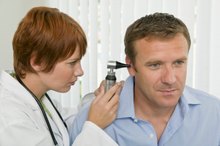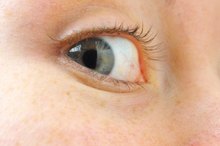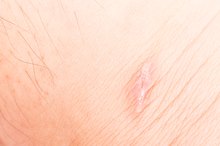I Have a Cyst on My Cheek Bone
Epidermoid cysts, commonly called sebaceous cysts, are bumps that develop beneath the surface of the skin, particularly the skin of the face, neck and trunk 12. Sebaceous cysts typically aren't dangerous, although large cysts, especially on the face, may affect appearance or interfere with daily life 12. The cyst on your cheek bone will likely diminish with time and proper home care, but if it becomes very large or infected, your doctor may remove it surgically.
Symptoms
If the bump on your cheek bone is indeed a cyst, it is likely round in shape and yellow or white in color. You should be able to move it around easily with your fingertips. Its size may range from less than 1/4 inch to up to 2 inches in diameter. A sebaceous cyst is usually not painful, but if it becomes infected you may experience tenderness, redness or swelling. A white or yellow substance may drain from the cyst.
- If the bump on your cheek bone is indeed a cyst, it is likely round in shape and yellow or white in color.
Causes
White Bumps on the Top of My Ears
Learn More
Sebaceous cysts are normally caused by an abnormal proliferation of skin cells that results in a blocked hair follicle 12. A skin injury, inflammatory skin condition or ruptured sebaceous gland may cause skin cells to multiply abnormally and block a hair follicle, creating the walls of a sebaceous cyst. The skin cells that form the wall of the cyst secrete a protein called keratin into the interior of the cyst, giving the cyst its round shape and white or yellow color. People with acne or surgical wounds are at a higher risk for developing a sebaceous cyst.
- Sebaceous cysts are normally caused by an abnormal proliferation of skin cells that results in a blocked hair follicle 1.
- A skin injury, inflammatory skin condition or ruptured sebaceous gland may cause skin cells to multiply abnormally and block a hair follicle, creating the walls of a sebaceous cyst.
Treatments
Home treatment for a sebaceous cyst involves applying warm compresses to the cyst to promote drainage. Most cysts will resolve without medical treatment. For very large cysts that are infected or of cosmetic concern, your doctor may prescribe antibiotics, inject a steroid into the cyst, or drain the cyst to reduce inflammation. Your doctor may also surgically remove the entire cyst using either a traditional excision or carbon dioxide laser which minimizes scarring.
- Home treatment for a sebaceous cyst involves applying warm compresses to the cyst to promote drainage.
- Your doctor may also surgically remove the entire cyst using either a traditional excision or carbon dioxide laser which minimizes scarring.
Complications
Weightlifting and Armpit Cysts
Learn More
Occasionally, infected sebaceous cysts may rupture, forming painful abscesses that require prompt treatment including antibiotics, surgery, or both 12. These abscessed cysts may return after surgical removal. In rare cases, sebaceous cysts can cause basal or squamous skin cancer 12. However, this occurs so seldom that cysts usually aren't biopsied unless they are immobile, solid, infected or have other strange characteristics.
When to See a Doctor
Most sebaceous cysts aren't harmful, but it is important to see a doctor if you suspect your skin has become infected 12. Make an appointment with a health professional if you have a cyst that becomes painful, grows rapidly, ruptures or keeps coming back in the same place. Any hard, painless bumps on the face should be examined by a doctor for signs of skin cancer.
Related Articles
References
- MayoClinic.com: Sebaceous Cysts
- MedlinePlus: Sebaceous Cysts
- MedlinePlus: Abscess
- MayoClinic.com: Skin Cancer
- Zito PM, Scharf R. Cyst, epidermoid (sebaceous cyst). StatPearls. Updated May 15, 2018.
- Hoang VT, Trinh CT, Nguyen CH, Chansomphou V, Chansomphou V, Tran TTT. Overview of epidermoid cyst. European Journal of Radiology Open. doi:10.1016/j.ejro.2019.08.003
- Sempowski IP. Sebaceous cysts. Ten tips for easier excision. The College of Family Physicians of Canada. 2006;52(3):315-317. PMID: 16572575
- Johns Hopkins Medicine. Sebaceous cysts. 2019.
- Garcia-Zuazaga J, Ke MS, Willen M. Epidermoid cyst mimicry: report of seven cases and review of the literature. The Journal of Clinical and Aesthetic Dermatology. 2009;2(10):28-33. doi:10.1016/j.jaad.2016.07.013
- Weir CB, St.Hilaire NJ. Epidermal inclusion cyst. StatPearls. Updated August 11, 2020.
- Song SW, Burm JS, Yang WY, Kang SY. Minimally Invasive Excision of Epidermal Cysts through a Small Hole Made by a CO2 Laser. Arch Plast Surg. 2014;41(1):85-8. doi:10.5999/aps.2014.41.1.85
- Goldstein BG, Goldstein AO. Overview of Benign Lesions of the Skin. In: UpToDate, Dellavalle RP (Ed), UpToDate, Waltham, MA. doi:10.3889/oamjms.2018.027
- Higgins JC, Maher MH, Douglas MS. Diagnosing Common Benign Skin Tumors. Am Fam Physician. 2015 Oct 1;92(7):601-07. PMID: 26447443
Writer Bio
Shannon George, former editor-in-chief of the trade magazine "Prime," holds a Bachelor of Arts in English from San Diego State University. Her health interests include vegetarian nutrition, weight training, yoga and training for foot races.









